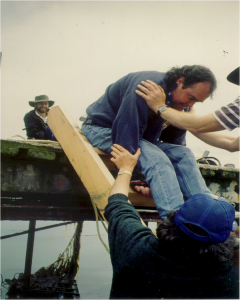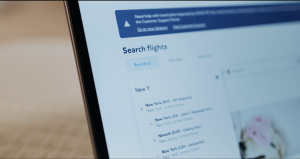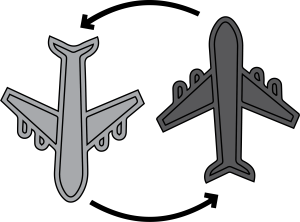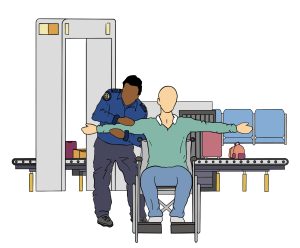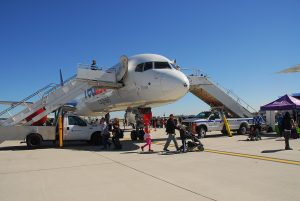Authors: Sharon Jang, Dominik Zbogar | Reviewers: Duncan Campbell, Janice Eng | Published: 16 November 2022 | Updated: ~
Key Points
- Many people living with a spinal cord injury (SCI) enjoy travelling, though with additional considerations.
- Consider your sitting tolerance, accessibility of the location, and transportation when selecting your destination.
- When packing, pay special attention to your medications and potentially wheelchair parts.
- When flying, your plan will consider selecting a flight with/without layovers, how you will transfer in/out of your seat, and access to the washroom.
Having a SCI should not stop you from travelling! Many people living with an SCI enjoy travelling, but there are additional factors to be considered when trip planning. According to one study, people with SCI spend more time planning trips in comparison to able-bodied individuals as they require more time to verify information found online. Some of this information includes destination, hotel/accommodation, transportation, and SCI specific information. For example, hotel rooms listed online as accessible were found to not always be accessible (e.g., they may have a step to get in).
 When planning a vacation, the first step is to choose a destination. Your destination may be based on attractions you want to see, accessibility of a location, or how far away it is from you. The distance you need to travel is important to consider as the further you go, the more sitting you will have to do. When selecting a destination, think about how long you are able to realistically sit comfortably for. If you can only sit for a couple of hours, perhaps a driving trip may be more appropriate as it allows you to take breaks whenever you want. If you are able to handle long periods of time without requiring pressure relief or stretching, then a longer international flight may work for you.
When planning a vacation, the first step is to choose a destination. Your destination may be based on attractions you want to see, accessibility of a location, or how far away it is from you. The distance you need to travel is important to consider as the further you go, the more sitting you will have to do. When selecting a destination, think about how long you are able to realistically sit comfortably for. If you can only sit for a couple of hours, perhaps a driving trip may be more appropriate as it allows you to take breaks whenever you want. If you are able to handle long periods of time without requiring pressure relief or stretching, then a longer international flight may work for you.
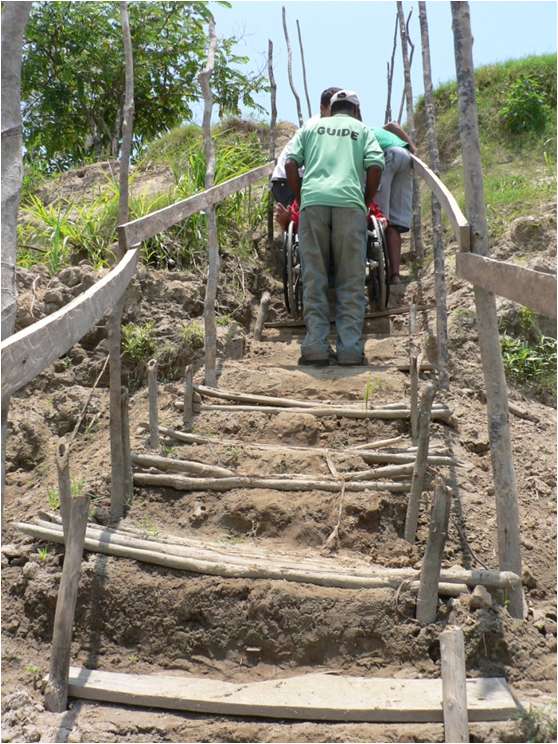 This set of stairs was the only way in from a large tour boat to a Brazilian village. I could have stayed on the boat and just waited for the group to come back, but the ship crew were very willing to carry me, and with a little direction as to where and how to hold and lift we pulled it off – not without a few shaky moments, but overall very well done! I found in many settings which were used to tourists and travelers that the staff involved were very helpful and happy to help. Duncan’s Experience“As you travel more, you start to realize that a given region or country can have common characteristics which can affect your travel. Examples are that Brazil has very thin bathroom doors. In Kenya the hotel may have entrance stairs, but they also have guards at the door who are more than willing to lift you up the stairs. In Thailand most bathroom doors are simply the same size as all other doors and many of the bathrooms have a showerhead in the wall and the whole bathroom is tiled, i.e. the shower is not enclosed – instant wheel-in shower! In China the national airlines have very little knowledge, experience, or facilities for people with disabilities. This is only the tip of the iceberg as cities and countries can have their own unique travel characteristics, but one thing that came to light through all my travels was that people in general and especially people in the travel industry can be very helpful.” |
Health concerns
Travelling with SCI can come with additional concerns around health. If you are worried about health concerns that may arise, talk to your SCI physician and ask if they know of any specialists or specialized medical centers in the area you plan to travel to. In addition, take a look at whether there are any hospitals/larger medical centers around your travel destination. Be sure to check if your health insurance is accepted at your location of travel, should a medical issue arise.
Wheelchair maintenance
It may be beneficial to look into medical equipment repair shops at the travel destination in case your wheelchair requires maintenance or repairs, or if spare parts are required. Where such a repair center may not exist, the best alternative is to find a bicycle shop. Many of the parts are interchangeable and they are usually very helpful.
Power assist
If you are using a manual chair, a power assist device may be worth considering as long distances and rough terrain can surprise you when travelling. Another device to consider is something called a FreeWheel which allows a manual chair to travel on much rougher terrain, such as cobblestone, grass, and gravel. It is also easily transported.
Refer to our article on Wheelchair Propulsion Assist Devices for more information!
After you have selected a destination, think about where you will stay when you arrive. Hotel accessibility is important to consider to make your stay comfortable. When picking accommodation, think about your needs and how they may be accommodated. Some things to consider when selecting a hotel include:

Whether a power chair or a manual chair (as pictured here) know how wide your wheelchair is at its widest point.
- Shower needs: Does the hotel have a roll in shower? If not, are there rooms with a handheld shower?
- Mobility needs: How wide are the doorways to the room and to the bathroom? Can the bathroom door be removed? Is there carpet? If so, how thick is the carpet? Will you be able to roll on it?
- Transfer needs: What is the height of the bed? Can the bedframe be removed if it is too high? What is the space between the bed and the wall? What is the height of the toilet in the bathroom? Can you get on the toilet? Is there space to transfer onto a toilet?
- Assistance needs: are attendants charged full price for an extra room? Are there adjoining rooms?
- Transportation: Is there accessible parking? If taking public transit, is public transit located close and is the route to the stop accessible?
The standard width for interior doors can depend on the country and will usually range from 711-914 mm (28-36 inches) though older buildings may have doorways built before standards were established.
In the USA, standard toilets are 15-16 inches whereas ADA (Americans with Disabilities Act) compliant toilets are 17-19 inches from floor to seat.
If you are ever unsure about a room, ask the hotel staff to view the room prior to checking in to ensure that it meets all of your needs.
Once you arrive at your destination, you will need a way to get around. When you arrive at the airport, some airports have private shuttles that are accessible. However, it is important to note that the definition of “accessible” varies greatly, so it is best to call the company directly to ensure it is accessible to you. For travelling around town, some countries may have accessible public transit, which may work for you. Other individuals might consider renting an accessible vehicle. If renting a vehicle is the way to go for you, ensure you call the car rental agency well in advance to ask if they have an accessible vehicle (e.g., one that has a ramp, hand controls) and reserve it. Not all rental companies have wheelchair accessible vehicles ready!
Travel cushions
Another type of equipment to consider is a travel cushion. These are typically small, lightweight making them easy to travel with. You do need to try different cushions before travel to find the one that works best for you. Any cushion used for travel or time outside of the wheelchair should be assessed by a therapist to ensure appropriate pressure relief is being achieved.
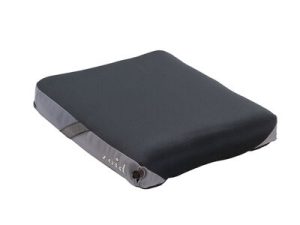 The Varilite Zoid is another air cushion that is like a camping mattress. |
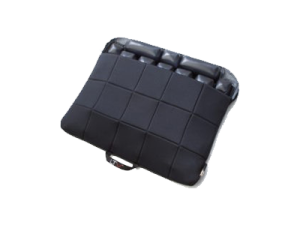 The ROHO LTV Seat Cushion is light and easy to put into a bag. |
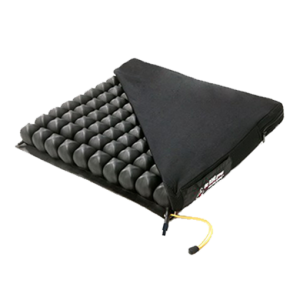 The ROHO Low profile single compartment Cushion is also light, foldable, and washable but unlike the LTV requires a pump to manage the air. |
 The Purple Portable Seat Cushion may be a good option for those with incomplete injury as the pressure relief is not as good. They may be fine for car cushions or on other equipment such as lawnmowers. |
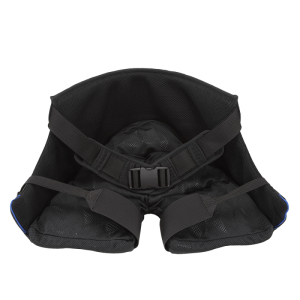 The Vicair AllRounder 02 Activity Cushion is used by many for sports and outdoor activities with the attachment that clips onto the body. Others just use the cushion part for car seats or airplane seats. |
|
Packing for a trip can be stressful! On top of your clothing, shoes, toiletries, and other typical travel items, you may need to pack other additional items such as medications and medical supplies.
Medications
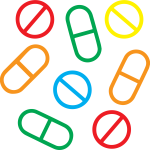
When travelling, be sure to pack enough medications for the entire duration of your trip. If you are prone to certain illnesses, such as urinary tract infections, you might want to consider bringing a dose of antibiotics with you for a trip – consult your doctor on this. However, for all of your prescription medications that you pack, make sure that you have them in their original bottle with the dosage and medication name on it. Note, the liquid limit when flying does not apply to medications. Also, do your research and ensure that all of your medications are legal in your destination country and any other layover countries you may stop in. For example, cannabis is increasingly used to treat SCI-related pain or spasticity but is prohibited in many countries.
Packing a carry-on
If you are flying, your carry-on should contain everything you need for 2-3 days in case your luggage gets lost. This includes clothing, medical supplies (such as catheters), and medications. When packing your carry-on, think about what items you might need during your flight. Keep these items easy access in your carry on, in case you need someone to help you access them.
Spare wheelchair parts 

If you are flying, it is a good idea to pack spare parts that could break or get lost in travel. For example, items such as a spare tube, cushion cover, or a compact tire pump should be considered. Some individuals prefer to fly with their own tools to make adjustments to their wheelchair after a flight. However, some tools may appear as weapons when you go through security, and may be confiscated. If you would like to pack your own tools, consider packing cheaper tools, and declare them at security.
Valuables
In tourist towns and port cities there are more thieves, and they will steal from you whether you have a disability or not. Keep your passport, credit cards, and money in a safe place like a travel pouch on your body.
Flying with an SCI requires special consideration at each step, from booking the flight, to getting on the plane, to getting off the plane. Below we review the process and considerations in each step of flying.
Contact the airline
The airline will always have the best, most up to date information.
Contact them well in advance to ask about their services and ensure they can arrange appropriate staff and equipment to assist you. Some questions to ask the airline include:
- Policy on attendants – some airlines will offer free or discounted flights for attendants. Note, some airlines may require a doctor’s note or pre-registration with the airline medical desk.
- Policy for baggage – with some airlines, luggage that consists of mostly medically necessary items will not be charged a baggage fee.
- Whether or not they can accommodate your wheelchair – does your wheelchair have a battery? If so, is it allowed on the airline? Will your wheelchair fit through the cargo door?
Booking the flight
Connecting flights
When booking flights, consider the length of the flight and whether having connections would be a benefit or hinderance for you. If you are unable to sit for long periods of time, you may want to consider travelling to a destination with a shorter flight time, or one with more connections. Having connections in your travel may allow you to use the washroom and change positions to relieve soreness/pressure, which can improve your overall comfort when travelling. If you do select to travel with connections, keep in mind the time required to get from one gate to another in a wheelchair, while also requiring time for comfort after a flight. In general, the time required to make a connecting flight should be double the time suggested for able bodied individuals. For longer over-seas flights, consider breaking up your travel into multiple days – try finding a connection in a city you’d like to visit! Although connections have their benefits, they can also lead to some issues, such as getting your equipment/luggage lost or damaged.
Choosing a seat
Similar to connecting flights, the various seat selections on a plane each have their pros and cons, and is based on preference. Some individuals may prefer a window seat as other passengers will not have to climb over you as much. In addition, the window seat may provide some privacy for personal care tasks such as emptying a catheter bag. However, wheelchair users from one study reported that window seats may require a more difficult transfer that can lead to pain, and makes accessing the toilet more difficult should you choose to use one. This is why other individuals may prefer sitting in aisle seats, as they are easier to transfer into and access the washroom (no passenger to climb over), but you may have other passengers needing to get by you. If you are worried about the transfer, around 50% of armrests on a plane are designed to lift up to facilitate transfers. Ask your airline about this if you are interested in a window seat!
The amount of space a seat on a plane has is another consideration. Seats on some airlines can be small and cramped. This may lead to discomfort and decreased circulation. In combination with sitting for long periods of time, decreased blood circulation may increase the risk for swelling, especially in the legs. If you can afford it, some wheelchair users from an interview study preferred seats in business class, as there was more space for them to move around and seats were able to recline enough to help maintain posture and weight shift. The seats at the front of each section (bulkhead seats) may be ideal for some as they offer more legroom and space to transfer, but they are also harder to transfer into as the armrests do not lift up, and there is no accessible spot to store a carry-on bag.
Dressing for a flight
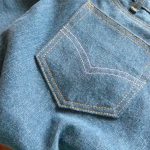
Avoid wearing denim as the pockets may dig into the skin after sitting for long periods of time.
On the day of your flight, try to wear comfortable clothing. Avoid clothing that have back pockets (such as jeans) as they may lead to pressure sores. In addition, avoid clothing that is restrictive. However, do consider wearing compression socks to help with swelling if this is something you experience.
Security screening
Security screenings for individuals using a wheelchair can be cumbersome. The process may be longer for wheelchair users as in some countries, the wheelchair and cushion will need to be swabbed, and you will receive a pat down. When going through security, some things to advise the security officer include:
- Your level of ability (e.g., are you able to stand, take a few steps, lean forward in your chair?)
- Things that may be attached to your body (e.g., an intrathecal baclofen pump, leg bags, drains)
- Any parts of your body that may be painful, hypersensitive, or lacking sensation.
To facilitate this process, check for rapid-access programs such as Transportation Security Administration (TSA) prechecks (Nexus/Global Entry), disability notification cards, or TSA Cares.
 When boarding the plane, you will usually be the first to board. This allows you extra time to transfer to your seat and to get comfortable without the pressure of other passengers waiting in the aisle behind you. Ask the airline about the boarding procedure, as it varies per airline. In general, you will remain in your wheelchair and travel to the door of the plane in it. You will then be transferred into an aisle chair. To facilitate the transfer, ensure you know how to guide the transfer through providing clear, verbal instructions to the airline staff. If you are unable to transfer from an aisle chair into your seat, some airlines have specialized slings that can be used to transfer you into your seat. Similar to the aisle chair, you will need to express your needs and guide your transfer from your wheelchair into the sling.
When boarding the plane, you will usually be the first to board. This allows you extra time to transfer to your seat and to get comfortable without the pressure of other passengers waiting in the aisle behind you. Ask the airline about the boarding procedure, as it varies per airline. In general, you will remain in your wheelchair and travel to the door of the plane in it. You will then be transferred into an aisle chair. To facilitate the transfer, ensure you know how to guide the transfer through providing clear, verbal instructions to the airline staff. If you are unable to transfer from an aisle chair into your seat, some airlines have specialized slings that can be used to transfer you into your seat. Similar to the aisle chair, you will need to express your needs and guide your transfer from your wheelchair into the sling.  The airline staff will then move you to your seat while you are in the sling. Once in your seat, take your wheelchair cushion and any removable parts off your wheelchair, and check that your wheelchair has a gate check tag on it. Make sure that any parts that stick out from your wheelchair are taped to the wheelchair or held in. Also, consider attaching a set of instructions on how to turn on and off a powered wheelchair circuit and how to operate it when the battery is not engaged. Remind the airline staff that your wheelchair will need to go under the plane for the flight. While you are getting settled in your seat, remember to:
The airline staff will then move you to your seat while you are in the sling. Once in your seat, take your wheelchair cushion and any removable parts off your wheelchair, and check that your wheelchair has a gate check tag on it. Make sure that any parts that stick out from your wheelchair are taped to the wheelchair or held in. Also, consider attaching a set of instructions on how to turn on and off a powered wheelchair circuit and how to operate it when the battery is not engaged. Remind the airline staff that your wheelchair will need to go under the plane for the flight. While you are getting settled in your seat, remember to:
- Smooth out clothing to avoid pressure sores
- Check any bladder equipment
- Put anything you need access to during the flight under your seat
Remember to do pressure relief
During your flight, remember to adjust your sitting position (weight shift) to alleviate pressure from sitting for an extended period of time. To address pressure, some individuals may choose to sit on their wheelchair cushion, which is designed for your seating needs in comparison to generic plane seats. However, participants from an interview study noted that sitting on your wheelchair cushion may add height and boost you up, making it harder to reach in-flight entertainment controls or the call button. In addition, being higher up make make it harder to brace yourself on the arm-rests for balance if you need the support. If you are considering using an air-filled travel cushion, be aware that it can become firmer while you are flying due to air pressure changes and may need to be adjusted.
Deep vein thrombosis
(DVT) is caused by the formation of a blood clot in a deep vein, most often in the legs. Often, clots will dissolve on their own. However, it is possible that a clot can break off and travel to the lungs causing a blockage known as a pulmonary embolism, which can be fatal. The risk of DVT exists (with risk increasing the longer you are sitting still) for those who have underlying risk factors such as decreased mobility. Talk to your doctor about the risk for blood clots before taking your trip and whether you would benefit from preventative treatments such as medications and compression stockings.
Going to the washroom on the plane

Lavatories on airplanes are small, awkward, and it can be hard to transfer onto the toilet.
Using the washroom (lavatory) on an airplane can be a pain – from transfering out of your seat, to maneuvering in a small washroom space. Some individuals use strategies to prevent the need to use the washroom on the plane. These include:
- Watching your liquid intake the day before, but not witholding fluid for longer flights
- Avoiding caffeine and alcohol 48 hours before a flight and while in flight
- Using the washroom in the airport before you get on the plane
- Using pads to help with unexpected leakage
- Using an overnight catheter bag (which is larger), and draining the bag into a water bottle. Some flight attendants are willing to empty it into the toilet for you.
If you do need to use the washroom on an airplane, be prepared to have to do a tight 180 degree transfer from an aisle chair to the toilet. You may require assistance from a flight attendant to help you get to the washroom, transfer to the toilet, and to return you to your seat.
Autonomic dysreflexia (AD)
The risk of AD is not increased by air travel per se but experiencing it during a flight can be more complicated due to difficulties with moving around the small flight cabin and lavatories. The most common trigger of AD is a full bladder. A full bowel is also a common cause of AD. If you have experienced AD, be familiar with your triggers and take steps to reduce risk before your flight by performing your bowel routine before going to the airport.
Refer to our article on Automatic Dysreflexia for more information!
Landing
 As the plane begins to descend, remind the flight attendant that your wheelchair is underneath the plane, and needs to be brought to the door upon landing. During the decent, individuals with limited core function may have some difficulty bracing themselves in the seat. One participant from an interview study explained that it felt like their “body wanted to fling forward”. If you find yourself in this situation, some ways to stabilize yourself in the seat include bracing yourself against the seat in front of you, or hanging onto the arm rests. Some individuals also opt to use a chest strap/abdominal binder to help support their position in the seat during landing.
As the plane begins to descend, remind the flight attendant that your wheelchair is underneath the plane, and needs to be brought to the door upon landing. During the decent, individuals with limited core function may have some difficulty bracing themselves in the seat. One participant from an interview study explained that it felt like their “body wanted to fling forward”. If you find yourself in this situation, some ways to stabilize yourself in the seat include bracing yourself against the seat in front of you, or hanging onto the arm rests. Some individuals also opt to use a chest strap/abdominal binder to help support their position in the seat during landing.
Deplaning
When getting off the plane, you will be the last to go. You will be transferred off the plane in an aisle chair or a sling, and your wheelchair should be waiting for you at the door of the plane. If your wheelchair is not there, it is suggested that you do not leave the plane. This is because while you are on the plane, it is seen as an immediate concern. This is opposed to leaving the plane without your wheelchair, as it becomes a baggage handling problem which is associated with delays and inconveniences. In the very rare case that your wheelchair gets lost, immediately talk to an airline staff and file a claim before you leave the gate you landed in. Most airlines will loan or rent you a wheelchair to use in the meantime while they locate your wheelchair. However, it is emphasized that lost wheelchairs do not occur often!
Baggage
You can ask other passengers or airline attendants for help getting your luggage off the baggage carousel. You can also request airport staff or porters for assistance in moving your bags to your next connection though in some countries you are expected to tip for this service.
An app is a program that is installed on your device. Mobile apps (i.e. apps you use on your mobile device) are a powerful tool for making travel easier.
Map apps
Perhaps the most useful overall, are apps that let you access maps and directions, specifically Google Maps (Android/iOS) and Apple Maps (iOS). These apps connect you with trip planning across modes of travel, include public transit schedules, and information about local businesses. Google Maps provides elevation data for many locations. There is also an “Accessible Places” feature in Google Maps which prominently displays wheelchair accessibility information.
Airline apps
Airline apps make it easy to book flights, check in, check for delays, and store your boarding passes. Some apps also let you to request disability assistance.
Public transit apps
Apps of public transit organizations will provide more detailed information, including specific accessibility information about that transit system, above and beyond the schedule information than you will find in Google Maps.
Accessibility apps
Accessibility apps provide information on accessibility of locations around the world. However, most are quite limited in the scope of what areas are covered. Two more popular options include Wheelmap (Android/iOS) and iAccess Life (Android/iOS). Remember too that Google Maps includes accessibility information.
Travelling is still possible after SCI! However, planning a trip may require more time and effort. This article attempts to provide you with as much information as possible about travel with SCI and it is likely not everything will apply for any single trip, so it may be simpler than you think! Travelling by car allows flexibility for rests and stops, while travelling by plane requires careful planning for boarding and disembarking, going through security, and using the washroom on a flight. Regardless, the world is still your oyster – get out there and travel!
It is best to discuss all treatment options with your health providers to find out which treatments are suitable for you.
For a review of how we assess evidence at SCIRE Community and advice on making decisions, please see SCIRE Community Evidence.
Byard, R.W. (2019) Deep venous thrombosis, pulmonary embolism and long-distance flights. Forensic Sci Med Pathol 15, 122–124. https://doi.org/10.1007/s12024-018-9991-9
Centers for Disease Control and Prevention (2022, June 9). Blood clots and travel. What you need to know. https://www.cdc.gov/ncbddd/dvt/travel.html
Craig Hospital. (2019, November 22). Air travel tips after an SCI or BI. https://craighospital.org/blog/air-travel-tips-after-an-sci-or-bi
Davies, A., & Christie, N. (2017). An exploratory study of the experiences of wheelchair users as aircraft passengers–implications for policy and practice. International Association of Traffic and Safety Sciences Research, 41(2), 89-93.
Dhanjal, M. (n.d.). Top 5 tips for planning wheelchair-accessible vacations. 180 Medical. https://www.180medical.com/blog/tips-planning-accessible-vacation/
SCI Forum. (2011, March 8). Travel after spinal cord injury: Finding your comfort zone. Northwest Regional Spinal Cord Injury System. https://sci.washington.edu/info/forums/reports/travel_2011.asp#report
Souza, R. (2017, October 5). 10 tips on how to take a long-haul flight with SCI. Christopher and Dana Reeve Foundation. https://www.christopherreeve.org/blog/daily-dose/10-tips-on-how-to-take-a-long-haul-flight-with-sci-guest-blogger-rodrigo-souza
Spinal Cord Injury BC. (2018). Your Accessible Travel Guide. https://sci-bc.ca/wp-content/uploads/2018/08/accessibletravelguideweb.pdf
Spinal Cord Injury Ontario. (n.d.). On the road again. https://sciontario.org/support-services/info-insights/living-with-an-sci/travel/
Image credits
-
- World Map – Abstract Acrylic ©Nicolas Raymond, CC BY 3.0
- Duncan’s Experience. Brazil
- Hotel Macdonald Edmonton Alberta 1a ©WinterE229 (Winterforce Media), CC0 1.0
- Modified from Disabled people set Free Vector ©Macrovector, Freepik License
- Wheelchair accessible taxi lift platform new farm park new farm ©John Robert McPherson, CC BY 4.0
- Zoid seating system ©ZoidTM 2021
- ROHO® LTV Seat® Cushion © Permobil 2021
- ROHO® Low Profile® Single Compartment Cushion ©Permobil 2021
- Activity Cushion Vicair AllRounder 02 ©VICAIR 2022
- Portable Seat Cushion ©purple 2022
- Duncan’s Experience. France
- Duncan’s Experience. New Zealand
- Duncan’s Experience. Kenya
- Medication ©Made, CC BY 3.0
- Luggage ©Llisole, CC BY 3.0
- Modified from Hand pump ©Oleksandr Panasovskyi, CC BY 3.0
- Hex tools ©b farias, CC BY 3.0
- Belt by Eucalyp from Noun Project
- Booking a flight online ©cottonbro, Pexels License
- Modified from charter flight ©ProSymbols, CC BY 3.0
- Empty row of airplane seats ©Jonathan Cutrer, CC BY-NC 2.0
- Jeans (Jean-ius Class on Craftsy) ©Kelly, CC BY-SA 2.0
- Airport Security. SCIRE Community Team
- Boarding Aircraft. SCIRE Community Team
- Sling Transfer. SCIRE Community Team
- Sukhoi Superjet 100 lavatory ©SuperJet International, CC BY-SA 2.0
- Landing plane ©barurezeki, CC BY 3.0
- FedEx – Federal Express (Morningstar Air Express) Boeing 757-2B7(SF) C-FMEP 904 (9741592213) ©Lord of the Wings, CC BY-NC 2.0
- Google Maps icon by Icons8





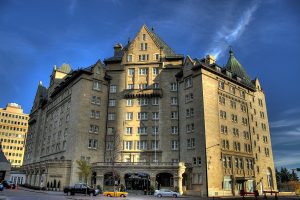
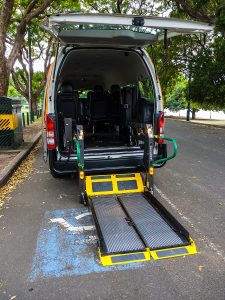
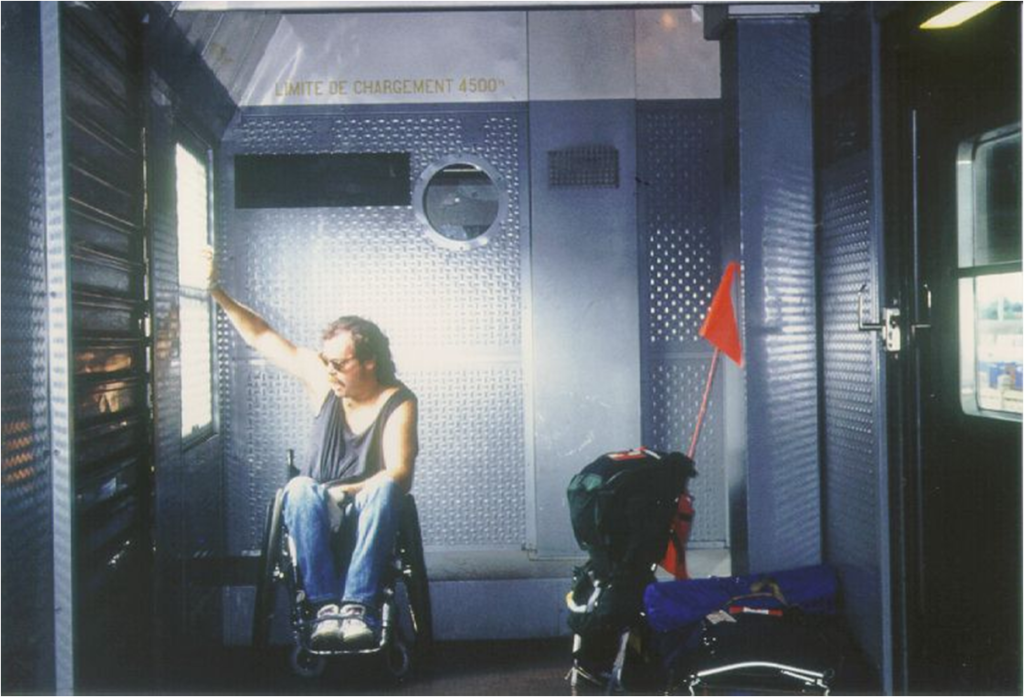 Duncan’s Experience
Duncan’s Experience